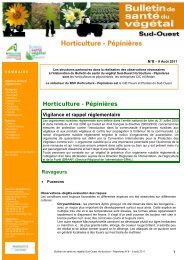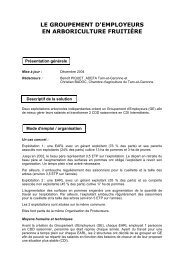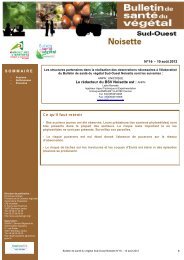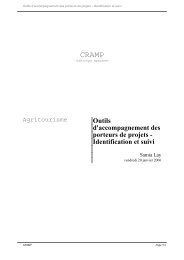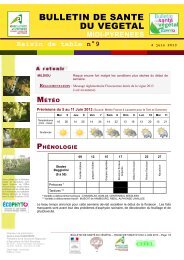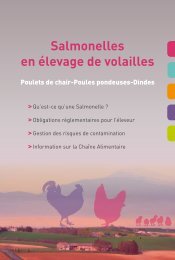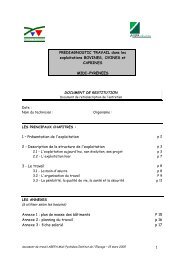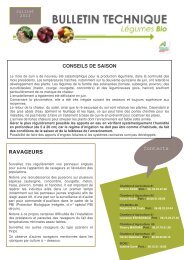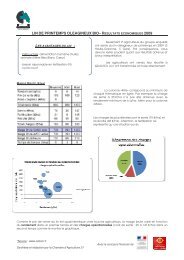guide technique fraise - Chambre d'Agriculture de Lot-et-Garonne
guide technique fraise - Chambre d'Agriculture de Lot-et-Garonne
guide technique fraise - Chambre d'Agriculture de Lot-et-Garonne
Create successful ePaper yourself
Turn your PDF publications into a flip-book with our unique Google optimized e-Paper software.
Irrigation1- Vérifiez la performance <strong>de</strong> votre installation d'irrigationlocalisée (Deman<strong>de</strong>z la fiche du GIE fruits <strong>et</strong> légumesd'Aquitaine <strong>et</strong> <strong>de</strong> la <strong>Chambre</strong> <strong>d'Agriculture</strong> Régionaled'Aquitaine contact 47: J. PRIM 05 53 77 83 34)2- Suivi à la tarière, tensiomètres, messages "Appui auxirriguants", suivi <strong>de</strong> l'ACMG. Cf. l'action agricole Fruitière <strong>et</strong>Légumière du Grand Sud Ouest n°75 supplément n°1 au1162 d'avril 2005.Gestion du climat <strong>de</strong>s abrisEn pério<strong>de</strong> humi<strong>de</strong> <strong>et</strong> en fonction <strong>de</strong>s abris, bien aérer lesabris au risque d'avoir un développement important <strong>de</strong>botrytis, tant au niveau <strong>de</strong> la végétation <strong>et</strong> <strong>de</strong>s cœursqu'au niveau <strong>de</strong>s fruits.Maladies <strong>et</strong> ravageursVolume bouillie: varie <strong>de</strong> 400 à 800 l/ha en fonction dusta<strong>de</strong> <strong>de</strong> la plante, <strong>de</strong> l'appareil d'application.La prophylaxie est indispensable pour limiter lesinfestations.Fournisseurs <strong>de</strong> plants bio ou nontraitésNom CoordonnéespépiniéristeLEBRUN Tél: 02 41 51 74 44Fax: 02 41 38 12 96e-mail:jplebrun49@yahoo.frPB2H 06 72 70 16 24DARBONNE Distributeur local <strong>de</strong>plants hollandais05 53 54 90 71MaladiesravageursTaupins, versblancsNémato<strong>de</strong>sChampignonspathogènesOïdiumXanthomonasPhytophthoracactorum <strong>et</strong>fragariaeVerticilliumBotrytisPuceronsNoctuellesdéfoliatricesTâches rouges<strong>et</strong> pourpresListe non exhaustive <strong>et</strong> évolutiveTraitements / ApplicationsTourteau <strong>de</strong> neem ou <strong>de</strong> ricinAppâts avec <strong>de</strong>s ron<strong>de</strong>lles <strong>de</strong> pomme <strong>de</strong>terrePrécé<strong>de</strong>nt tagètesDésinfection vapeur Inconvénients cher <strong>et</strong>longInterculture: engrais vert ex: sorghofourragerSoufre fleur ou microniséDérogation jusqu'au 31 décembre 2005Dose/ha: 3 kg/haCuivre type cuivrol 0,6 à 2,5 kgs/ha oubouillie bor<strong>de</strong>laise RSR 12,5 kgs/haTricho<strong>de</strong>rmaGestion climatiqueBiophytoz L23,5 l/ha Bien mouiller. Traiter le soir carphotodégradableBacillus thuringiensisCuivre type héliocuivreSoufre type héliosoufre+ solith (lithotamme = algue marine+ oligoéléments)= adjuvant adoucissantl'agressivité du Cuivre ou du soufre sur laplante. Utiliser au moins 1 mois avantrécolte. Tâche les plantes. Dose: 1 à 2 l/haAleuro<strong>de</strong>s Mycotal 1 g/lVolume <strong>de</strong> bouillie> 1000 l/ha18 à 28°C, 70% minimumd'hygrométrie durant 3jours après l'applicationNe pas faire <strong>de</strong> fongici<strong>de</strong>s3 jours avant <strong>et</strong> aprèsl'applicationAcariens SoufreLimaces Orthophosphate <strong>de</strong> ferRongeurs Pièges englués9




